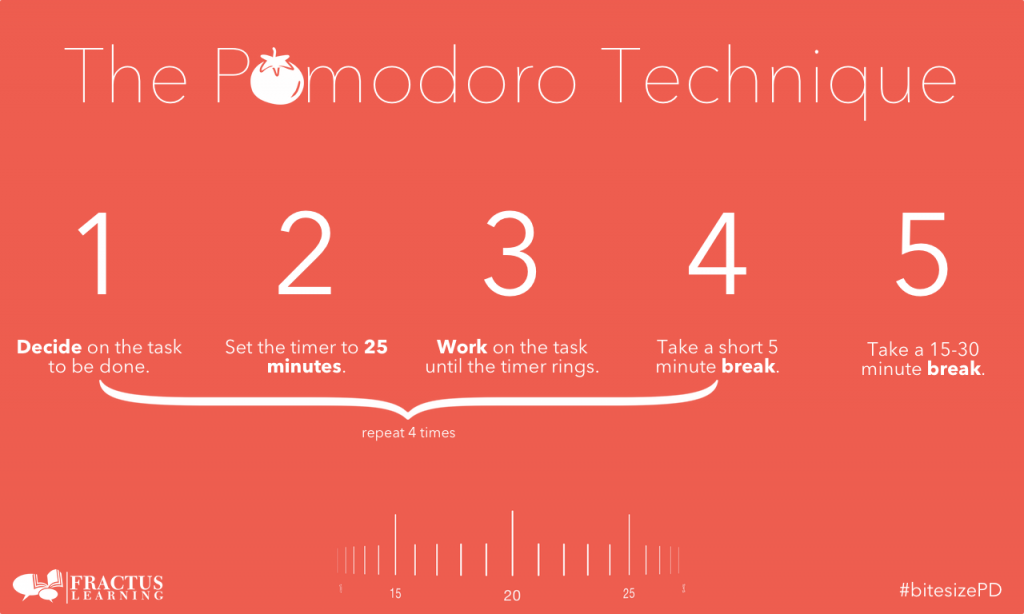The Pomodoro (Tomato) technique was first developed by the Italian Francesco Cirillo in 1980’s while he was a university student. He uses a tomato shaped kitchen timer as the main timer for when he is focusing on a specific task for a set amount of time. The technique itself is a time management method which is best used to understand how much a task takes to be completed and to provide a physical connection between work focus and time.
Originally, the technique involves 6 steps which are:
- Deciding on what task to tackle.
- Setting the timer to the preferred time allotment (usually the standard is 25 minutes per focus session).
- Working on the task when the timer is on.
- Ending the tasks when the timer rings and taking a short break (around 5-10 minutes)
- The standard is to finish 4 sessions in a set. If you end up having fewer than 3 sessions, you can go back to step 2.
- After three sessions, finish the fourth session to complete the set and take a long break (around 20 to 30 minutes) after which you can start another set of 4 sessions.

What technique does this technique teach your brain? The main idea is that you can get short bursts of focused time that allows you to work on a task without distraction.
- Because the technique allows you to be physically part of the self-contract – the setting of the timer and the ringing of the alarm, your brain is wired to have short goals. The act itself of starting the timer creates a feeling of determination and the act of working while waiting for the timer to alarm is an act of reward seeking – thus the short break after each session.
- Because you have worked on the task with focus, you can easily determine how much time is therefore needed for a specific task and will give you a more precise estimate of the timeframes of the tasks of the same kind. This allows you to prioritize and segment your tasks based on their estimated completion time. This makes the technique very ideal for studying, writing, coding, and other repetitive work.
- It allows you to internally learn the dynamics of setting blocks of focused work alongside breaks which relieves you from too much cognitive overload.
Do I really need to complete a set? The answer is no. Start with what is comfortable for you. Start with the tasks that really require your full attention and use the technique to help you focus on it. Remember, the first step in fully using the technique is to train your brain.
What can you do to fully maximize the technique?
- Remember that it is also brain training. If you finish your task before the alarm rings – go back to what you have worked, check for errors, and refine. The extra time allows you to quality check your work before moving on to the next. Log that task as one requiring a lesser amount of time to finish. In such a way, you can set the timer for that task properly next time.
- What if the bell rings and you are not done yet? Take a short break, breathe, and relax, before going back to the task. Remember that too much focus also drains you out. The break time allows you to think lightly and freely look back at the problems you encountered while doing the task. Later, log how many sessions are required for that task. On the next time you are faced with the same task, delegate it in the mornings or when you are most active.
- Use music that does not distract you while doing a task. For example, some students like listening to music with lyrics when they are solving problems or drafting essays but use instrumental music when reading. Learn how you react to music and if it helps you focus or not. Why are we talking about this? Well, some students do not have the luxury of having quiet and clutter free learning spaces and personal music may help alleviate the distraction from the auditory clutter.
Here are some recommended applications if you wish to try this out:
- Forest (focus timer)
- Spotify (look for pomodoro playlists you can use as a timer)
- Phone timer
Or if you want to go traditional, get your kitchen timer.
Just do not tell your mom you will be using it indefinitely.
Links to other resources:
- https://francescocirillo.com/pages/pomodoro-technique
- https://www.forbes.com/sites/bryancollinseurope/2020/03/03/the-pomodoro-technique/?sh=4531bbd83985
- https://en.wikipedia.org/wiki/Pomodoro_Technique
- https://lifehacker.com/productivity-101-a-primer-to-the-pomodoro-technique-1598992730

